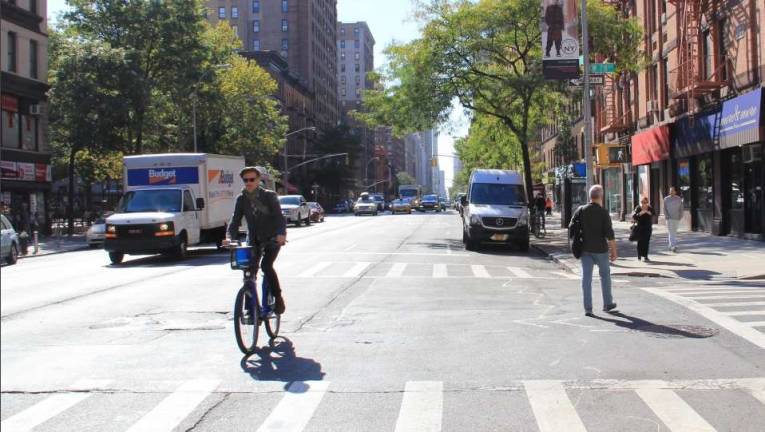Op-Ed: For A Safer Amsterdam Avenue

The Department of Transportation’s proposed safety redesign of Amsterdam Avenue has broad support from Upper West Side residents, businesses and other community stakeholders, but a small group of opponents is engaging in a last-ditch effort to block this commonsense project.
Earlier this month, despite a coalition letter signed by more than 200 businesses and petitions signed by more than 3,500 local residents, Community Board 7’s transportation committee failed to pass a resolution in support of the DOT’s designs for a safer Amsterdam Avenue.
Transportation committee co-chairs Dan Zweig and Andrew Albert each posed unworkable alternatives to the proposed northbound protected bike lane to complement the southbound lane on Columbus Avenue. All of these alternatives have already been studied, and they were found to be less-than-ideal by DOT officials, who opted for the current proposal.
The opponents of a safer Amsterdam Avenue have now proposed turning the existing Columbus Avenue bike lane into a two-way lane like those on Prospect Park West and Kent Avenue in Brooklyn, in an effort to stop wrong-way cycling on Columbus. While that may seem like a simple solution, it would actually be difficult to implement.
It would be impossible to mix zones where turning traffic merges into the bike lane, given that cyclists would be entering those zones against the flow of traffic. Every intersection would need a new split-phase signal, which would limit the amount of time pedestrians have to cross, and drivers have to turn, as well as be very expensive and undoubtedly delay safety improvements for years.
In addition, any northbound bike lane would eventually be tied into the rest of the bike network. Creating a two-way bike lane on Columbus Avenue would force the city to completely overhaul the Lincoln Square Bowtie that was just redesigned recently.
Another counterproposal calls for a northbound bike lane on the park side of Central Park West. That would be dangerous for cyclists and transit users alike, since passengers boarding the uptown M10 bus would be forced to cross the bike lane to reach the bus stop.
The same alternative design would also make Central Park West a one-way northbound avenue. But that would cause severe congestion in the neighborhood, as all southbound traffic, including the M10 bus, would be routed onto Columbus Avenue south of 110th Street. Residents of apartment buildings on Central Park West may have to travel out of their way to reach attractions such as the Museum of Natural History.
Traffic on Columbus Avenue would reach unbearable levels, causing gridlock throughout the Upper West Side with traffic spilling over onto Broadway and even West End Avenue. DOT has said during recent CB7 meetings that this proposal is unworkable.
The only feasible northbound complement for the Columbus Avenue bike lane is a northbound lane on Amsterdam Avenue. It would run right through the heart of the Upper West Side, giving users of an expanding Citi Bike network safe access to hundreds of local businesses. The bike share system saw 10 million trips last year, and that number is only expected to grow in 2016 as Citi Bike expands north towards 130th Street.
The proposed redesign would also make Amsterdam Avenue safer for other users of the street. The pedestrian islands in the DOT’s design decrease crossing distances, allowing pedestrians of all ages to cross the street more quickly than before. Amsterdam Avenue is the most dangerous northbound avenue on the UWS. Reducing the travel lanes from 4 to 3 will limit speeding, which is the leading cause of traffic-related injuries and fatalities.
When DOT brought a proposal for Second Avenue bike lanes to CB8, the board did not see a need to vote on it, as they concurred it was the natural complement to the lane on First Avenue. As a lifelong West Sider, I would hate to see my neighborhood fall behind the Upper East Side on street safety.
John Simpson is an Upper West Side resident.